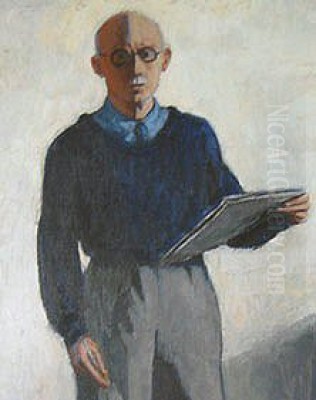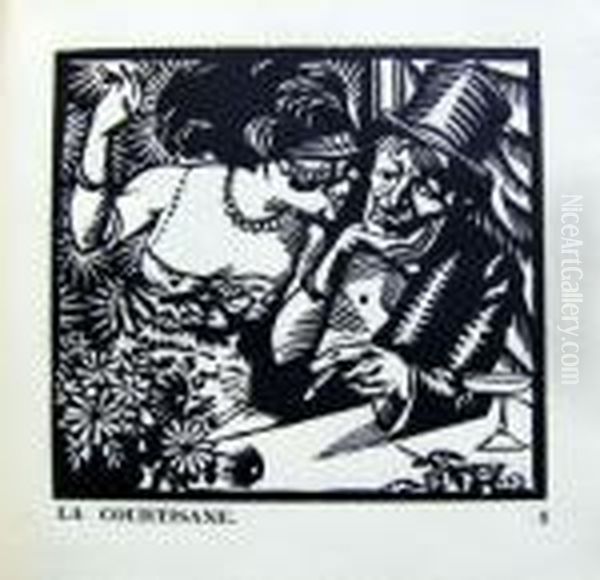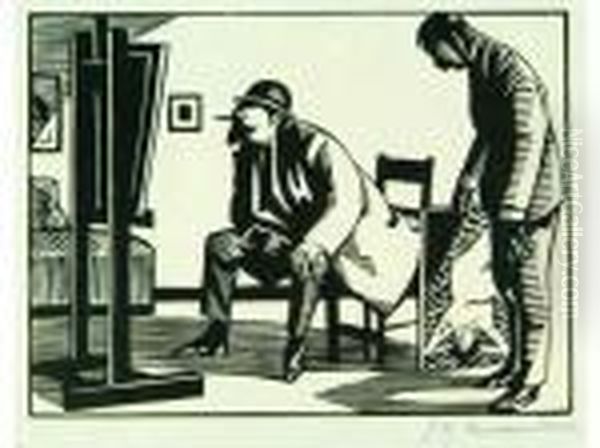
René Georges Hermann-Paul (December 27, 1864 – 1940) stands as a significant, if sometimes overlooked, figure in the vibrant Parisian art scene of the late 19th and early 20th centuries. A multifaceted artist, he distinguished himself as a painter, illustrator, printmaker, and, most notably, a biting satirist whose work captured the zeitgeist of his era. His keen observations of French society, its foibles, and its political turmoils were translated into powerful visual statements that resonated widely, from popular journals to gallery walls. Hermann-Paul's artistic journey reflects the dynamic shifts in European art, from Post-Impressionism and Symbolism to the stark realities depicted during wartime, leaving behind a legacy rich in social commentary and artistic innovation.
Early Life and Artistic Inclinations
Born in Paris into a prosperous family with roots in the south of France, René Georges Hermann-Paul's early life was marked by an expectation that he would follow a conventional path. His father, a respected physician, envisioned a scientific career for his son, hoping he would enter the medical field. However, the allure of Paris, the undisputed art capital of the world, and an innate passion for visual expression proved too strong. Despite his father's wishes, Hermann-Paul was drawn to the world of art.
He initially enrolled at the prestigious École des Beaux-Arts, a bastion of academic tradition. This formal training would have provided him with a solid foundation in drawing and painting. However, his artistic temperament sought broader horizons, leading him to later study at the École des Arts Décoratifs. There, he became a student of artists like Henri Lerolle, known for his naturalist and later symbolist paintings, and Gustave Colin, a landscape painter associated with the Barbizon school and Impressionism. This diverse educational background exposed him to various artistic currents, shaping his versatile approach to art-making.
The Emergence of a Satirical Voice

The late 19th century in Paris, often referred to as the Belle Époque, was a period of immense cultural ferment, technological advancement, and social change. It was also an era ripe for satire, with a burgeoning popular press that provided a platform for artists to comment on contemporary life. Hermann-Paul quickly found his niche in this environment, becoming one of the foremost satirical cartoonists of his generation.
His work began appearing in prominent illustrated journals such as Le Rire and Le Courrier Français, publications known for their witty and often irreverent social and political commentary. Hermann-Paul's style was characterized by its incisive wit, concise lines, and expressive power. He possessed an uncanny ability to distill complex social situations or character types into memorable, often humorous, visual critiques. His subjects ranged from the pretensions of the bourgeoisie and the absurdities of fashion to the more serious issues of political corruption and social injustice.
Pioneer in Poster Art and Printmaking
Alongside his work in satirical illustration, Hermann-Paul made significant contributions to the burgeoning field of poster art. This was a revolutionary period for the medium, with artists like Jules Chéret, considered the father of the modern poster, and the iconic Henri de Toulouse-Lautrec transforming street advertising into a vibrant art form. Hermann-Paul collaborated with Toulouse-Lautrec and others, contributing to the dynamism of Parisian visual culture. His posters, like his cartoons, were often marked by bold designs and a clear, impactful message.
Hermann-Paul was particularly adept in printmaking techniques, excelling in woodcuts and lithography. These mediums allowed for wider dissemination of his work and suited his graphic style. His woodcuts, often characterized by strong black-and-white contrasts and simplified forms, were particularly effective in conveying his satirical intent. Lithography, with its potential for nuanced tones and fluid lines, also featured prominently in his oeuvre. These prints were not confined to France; they circulated throughout Europe, establishing his reputation beyond Parisian circles.
Artistic Style: Influences and Characteristics
Hermann-Paul's artistic style was an amalgam of various influences, reflecting the eclectic nature of fin-de-siècle art. While his satirical work often relied on a direct and accessible graphic language, his broader artistic output shows clear connections to major contemporary movements.

Symbolism, with its emphasis on suggestion, emotion, and the inner world, left a discernible mark on his work. This can be seen in the evocative quality of some of his illustrations and paintings, where mood and atmosphere take precedence over literal representation. Artists like Odilon Redon and Gustave Moreau were key figures in French Symbolism, and their exploration of dreams, myths, and subjective experience resonated with many artists of the period.
The influence of Japanese Ukiyo-e prints, which had a profound impact on Western art in the late 19th century, is also evident in Hermann-Paul's compositions. The flattened perspectives, bold outlines, asymmetrical arrangements, and decorative patterning characteristic of artists like Hokusai and Hiroshige were adopted and adapted by many European artists, including Impressionists and Post-Impressionists. Hermann-Paul incorporated these elements to create visually striking and modern-looking works, particularly in his color prints and posters. His use of rich colors and unique viewpoints further attests to this engagement with diverse visual traditions.
His overall style can be described as concise yet highly expressive. He had a talent for capturing the essence of a subject with an economy of means, relying on strong lines and carefully considered compositions. Whether in black and white or color, his works possess a distinct graphic clarity.
The Dreyfus Affair: Art as Political Activism
One of the most defining and divisive events in late 19th-century France was the Dreyfus Affair, a political scandal involving the wrongful treason conviction of Alfred Dreyfus, a Jewish artillery captain in the French army. The affair polarized French society, exposing deep-seated anti-Semitism and challenging the integrity of military and judicial institutions.
Hermann-Paul was a staunch supporter of Dreyfus, aligning himself with the "Dreyfusards" who campaigned for his exoneration. He used his artistic platform to voice his convictions, creating powerful cartoons that criticized the flawed military tribunal procedures and condemned the pervasive anti-Semitism that fueled the injustice. His visual critiques of the affair were sharp and uncompromising, contributing to the public discourse and demonstrating the potent role art could play in social and political struggles. Artists like Jean-Louis Forain, though often on the anti-Dreyfusard side, also heavily illustrated the affair, highlighting the deep engagement of artists in this national crisis.
Documenting War: The Tragedies of World War I
The outbreak of World War I in 1914 profoundly impacted Hermann-Paul, as it did an entire generation of artists and intellectuals. His response to the conflict was multifaceted. Initially, like many, he may have been swept up in patriotic fervor, but as the war dragged on and its horrific human cost became apparent, his work increasingly reflected the tragedy and brutality of modern warfare.
He turned to the woodcut technique with renewed vigor to document the war's impact. His series of prints, such as Les Atrocités Allemandes (German Atrocities) and Deuil Boche (German Mourning), starkly depicted the suffering of civilians and the devastation wrought by the conflict. These works, while sometimes propagandistic in tone, also conveyed a growing sense of pacifism and a deep empathy for the victims of war. His wartime prints, such as the powerful series LA DANSE MACABRE (The Dance of Death), evoked a medieval theme to comment on the indiscriminate nature of death in modern conflict. These works stand as a poignant visual record of the era, comparable in their emotional weight to the war-themed art of contemporaries like Théophile Steinlen or Käthe Kollwitz in Germany.
Association with Les Nabis and Other Contemporaries
Hermann-Paul was associated with Les Nabis (Hebrew for "prophets"), a group of young Post-Impressionist avant-garde artists who were active in Paris from the late 1880s to around 1900. Key members included Pierre Bonnard, Édouard Vuillard, Maurice Denis, Paul Sérusier, and Félix Vallotton. The Nabis sought to break from Impressionism's naturalism, emphasizing flat planes of color, decorative patterns, and subjective expression, often drawing inspiration from Paul Gauguin and Japanese prints.
While Hermann-Paul may not have been a core member in the same vein as Bonnard or Vuillard, his stylistic affinities, particularly his interest in decorative qualities, simplified forms, and printmaking, align with Nabis principles. He exhibited alongside Nabis artists and shared their interest in integrating art into everyday life through illustrations, posters, and decorative arts. His friendship and collaborations with figures like Toulouse-Lautrec and his exhibitions with artists such as Henri Matisse further place him within the dynamic network of Parisian modernism. Vuillard, in particular, also contributed significantly to journals, and their paths would have crossed in publishing circles.
Diverse Artistic Mediums and Notable Works
Hermann-Paul's versatility extended across a wide range of artistic mediums. He was proficient in enamel paints, watercolors, woodcuts, lithographs, oil painting, and ink drawing. This mastery of diverse techniques allowed him to adapt his style to different purposes, from the bold graphics of posters to the nuanced tones of paintings and the sharp lines of satirical cartoons.
Among his representative works, several stand out:
Satirical Series: His series Monsieur Quelconque (Mr. Anybody/Everyman) and Madame Quelconque (Mrs. Anybody/Everyman), such as La Vie De Madame Quelconque En Dix Tableaux, offered a humorous yet critical look at the aspirations and daily lives of the French middle class, exposing societal norms and class distinctions.
Wartime Prints: As mentioned, Les Atrocités Allemandes and LA DANSE MACABRE are powerful examples of his wartime art, capturing the grim realities of the conflict.
Book Illustrations: He was a prolific book illustrator. His twelve color woodcuts for a work on Goya, for instance, demonstrate his skill in interpreting literary or historical subjects through his distinct visual language. His illustrations for children's books, such as Goyas pour les Enfants, also showcased his adaptability.
Social Commentary Cartoons: Individual cartoons like Civilization and Barbarism (1899) encapsulated complex social critiques, in this case, questioning the supposed superiority of "civilized" societies.
Urban Life: Works like Escargots d’omnibus (Snails on the Omnibus) humorously depicted the crowded and slow-paced nature of public transport in Paris, a common theme for artists observing modern urban life.
His use of Ripolin enamel paint, an industrial paint, in some exhibitions, including those with the "First Group," demonstrated his willingness to experiment with unconventional materials, a trait shared by many avant-garde artists of the time.
Later Career and Stylistic Evolution
The aftermath of World War I brought significant changes to European society and art. For Hermann-Paul, the post-war period saw a gradual shift in his artistic focus and style. While he continued to produce satirical work, there was an increasing introspection in his art. He began to explore more personal themes, focusing on individual emotions and the inner world.
Still life painting became a more prominent genre in his later work. These compositions, often featuring everyday objects, allowed for a quieter, more contemplative mode of expression. Notably, clocks and timepieces frequently appeared in his later paintings, perhaps reflecting a meditation on the passage of time, mortality, and the changing world around him. This thematic concern with time suggests a departure from the immediate social and political engagement of his earlier career towards more universal and personal reflections.
Exhibitions, Collections, and Enduring Recognition
Throughout his career, Hermann-Paul's work was exhibited in numerous galleries and salons in Paris and beyond. His art found its way into significant public and private collections, attesting to its contemporary appeal and historical importance.
Today, his works are held by institutions such as:
The McNay Art Museum in San Antonio, Texas, which holds works like The Barrson Sisters.
The Musée d'histoire culturelle d'Osnabrück in Germany, which houses his wartime etchings like Les Atrocités Allemandes.
Yale University Library, which has collected some of his illustrative work, including pieces on sensitive social topics.
The Contemporary Art Museum (CAM) St. Louis, which includes his woodcuts in its collection.
The Sylvan Cole Gallery in New York also played a role in showcasing his work to American audiences. Furthermore, initiatives like The Online Hermann-Paul Project continue to research and promote his artistic contributions, ensuring that his legacy is preserved and accessible to new generations. These collections and ongoing scholarly interest underscore his lasting significance in the narrative of modern art.
Legacy and Historical Significance
René Georges Hermann-Paul died in Saintes-Maries-de-la-Mer in 1940, at a time when Europe was once again engulfed in war. He left behind a substantial body of work that offers a rich visual chronicle of his era. His most enduring legacy lies in his contributions to satirical art. He was a master of the genre, using humor and caricature not merely for entertainment, but as potent tools for social critique. His sharp eye and incisive wit exposed the hypocrisies, injustices, and absurdities of French society at the turn of the century and beyond.
He was an artist deeply engaged with the world around him, responding to its political upheavals, social transformations, and cultural currents. From the Dreyfus Affair to the trenches of World War I, his art served as both a mirror and a commentary. His stylistic versatility, his mastery of printmaking, and his pioneering work in poster art further solidify his place in French art history.
While perhaps not as universally recognized today as some of his contemporaries like Toulouse-Lautrec or Nabis members such as Bonnard and Vuillard, Hermann-Paul's contributions were significant. He was part of a generation of artists who redefined the role of visual art, expanding its reach into popular culture and harnessing its power for social and political expression. His work continues to be studied for its artistic merit, its historical insights, and its sharp, often timeless, observations on the human condition. He remains an important figure for understanding the complex artistic and social landscape of France in the late 19th and early 20th centuries, a period of profound change and artistic innovation.